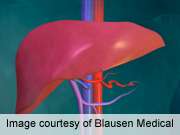Earlier life adiposity trajectories linked to NAFLD in teens

(HealthDay)—Earlier life trajectories of adiposity are associated with nonalcoholic fatty liver disease (NAFLD) in adolescents, according to a study published in the January issue of theJournal of Gastroenterology and Hepatology.
Oyekoya T. Ayonrinde, M.B.B.S., from the University of Western Australia in Perth, and colleagues examined the correlations between NAFLD diagnosed during adolescence and earlier lifetrajectoriesof anthropometry in a population-based cohort. Questionnaires and liver ultrasound were used to assess NAFLD in 1,170 adolescents aged 17 years.
The researchers found that 15.2 percent of adolescents were diagnosed with NAFLD. There was no association for birth anthropometry, including birth weight, skinfold thickness, and ponderal index, with NAFLD. Adiposity differences between 17-year-olds with and without NAFLD were evident from age 3 years. There were correlations for greater adiposity trajectories for weight,body mass index, skinfold thickness, mid-arm circumference, and chest circumference from age 3 onward with NAFLD diagnosis and severity ofhepatic steatosisat age 17 years, particular in males (P < 0.05). For each adiposity measure, the strength of associations increased with age after 3 years (all P < 0.001).
"Trajectories of childhood adiposity are associated with NAFLD," the authors write. "Exploration of clinically relevant risk factors and preventative measures for NAFLD should begin during childhood."
Copyright © 2015HealthDay. All rights reserved.


















